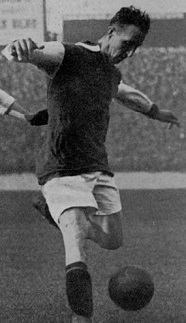Stanley George
James Earle
Date of Birth/Death: 6 September 1897/26 September 1971 (aged 74)
Place of Birth: Stratford, England
Nationality: English 🏴
Height: 6 ft 1 in (1.85 m)
Position(s): Inside-right
Arsenal Youth Career: N/A
Arsenal Senior Career: 1921-24
Senior Apps/Goals: 4/3
General Information
Stanley Earl (born 6 October 1897 – died 1978) was an English inside forward who had a brief but memorable spell with Arsenal in the early 1920s. Known for his technical ability and eye for goal, Earl’s career reflected the challenges of football in the interwar period, when competition for places at top clubs was fierce and opportunities limited.
Early Life
Stanley Earl was born in West Ham, London, in 1897. Growing up in East London during a time when football was rapidly growing as a spectator sport, he developed his skills playing in local leagues. His ability as a forward soon drew attention, and after serving during the First World War—as so many of his generation did—he turned towards pursuing football more seriously in the years that followed.
Early Career
Earl began his senior football career with Southend United. Playing in the lower leagues, he quickly demonstrated an eye for goal and the technical qualities needed to operate as an inside forward. His performances for Southend attracted scouts from bigger clubs, and Arsenal, seeking to build a strong attacking unit in the post-war years, made their move.
Arsenal Career (1925)
In 1925, Earl signed for Arsenal, then under the management of Leslie Knighton, just before the transformative Herbert Chapman era. Competition for places in Arsenal’s forward line was intense, with several experienced attackers already in the squad.
Earl made just a single senior appearance for Arsenal, which came in a First Division match against Liverpool on 10 October 1925. Though he did not score, his presence at the top level marked the highlight of his professional career. Unfortunately, opportunities were scarce, and he was unable to secure a regular place in the side.
While his time at Arsenal was short, it placed him in the company of some of the era’s most influential players and managers, and ensured that his name became part of the club’s long and storied history.
Later Career
Following his departure from Arsenal, Earl continued his career in the Football League with Clapton Orient (later Leyton Orient). He enjoyed more opportunities at the club, contributing goals and experience to the side. His professional career at the higher levels of English football was relatively brief, but he remained active in the game into his later playing years, representing smaller teams before eventually retiring.
Playing Style
Earl was an inside forward—a role that demanded both creativity and finishing ability. He was known for his intelligent movement, short passing, and ability to link midfield play with the forwards. While not the most physically dominant player, his technique and footballing intelligence made him a useful addition to any squad.
Life After Football
After stepping away from professional football, Earl lived a quieter life outside of the spotlight. Like many players of his era, he did not enjoy the financial rewards seen by modern footballers and likely pursued work away from the sport. Records of his later life are limited, though it is known he passed away in 1978 at the age of 80.
Legacy
Though his Arsenal career amounted to just one appearance, Earl remains part of the club’s official history, representing the generation of players who helped carry the game forward in the years following the First World War. His story is one of perseverance, of reaching the top level even if only briefly, and of contributing to English football during an era when the game was still evolving into its modern form.
| Season | Appearances | Goals |
| 1921-1922 | 1 | 0 |
| 1922-1923 | 1 | 1 |
| 1923-1924 | 2 | 2 |


